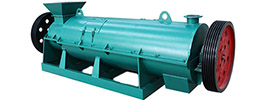The wet granulation process is commonly used in compound fertilizer production. Its core characteristics can be summarized as follows, integrating the process principles, advantages, and limitations:
I. Process Principles and Core Workflow
Wet granulation involves mixing powdery fertilizer raw materials (such as nitrogen, phosphorus, and potassium base fertilizers, organic matter, etc.) with a liquid binder (such as water, ammonia water, etc.) to form a plastic soft material, which is then shaped into granules through mechanical force (such as a rotating disk, stirring) or fluid action (such as spray drying). The typical process includes:
- Mixing and Pulping: The raw materials and binder are mixed in a mixer to form a moldable soft material.
- Granulation and Shaping: Wet granules are produced using equipment such as a disk granulator or rotating drum granulator.
- Drying and Cooling: The wet granules are dehydrated and hardened in drying equipment (such as a fluidized bed or rotary kiln).
- Screening and Packaging: The finished product is obtained after grading and screening.
II. Main Advantages
- High Granule Quality
- Uniform Density: The liquid binder promotes tight bonding of the materials, resulting in high hardness and resistance to disintegration.
- High Forming Rate: Suitable for low-viscosity or fine powder raw materials, with a granule formation rate of over 90%.
- Smooth Surface: Reduces dust and nutrient loss during transportation.
- Uniform Nutrient Distribution
- More thorough mixing in a wet state prevents component segregation that can occur in dry granulation.
- Suitable for formulas containing trace elements or organic-inorganic compound fertilizers.
- Process Flexibility
- Adjustable Particle Size: By replacing screens or adjusting equipment parameters (such as disk inclination, rotation speed), granules of different specifications (1-5mm) can be produced.
- Strong Formula Compatibility: Allows addition of liquid functional ingredients such as humic acid and amino acids.
III. Limitations
- Energy Consumption and Costs
- Requires auxiliary drying equipment (such as steam-heated air furnaces), with energy consumption accounting for 20%-30% of production costs.
- Binder consumption (such as urea solution) increases raw material costs.
- Environmental Pressure
- Drying exhaust gas contains dust and ammonia, requiring exhaust gas treatment systems.
- Large volume of wastewater treatment (such as spray water circulation systems).
- Equipment Complexity
- Long process flow, requiring multi-equipment collaboration (mixer → granulator → dryer → screener).
- High maintenance costs, such as regular replacement of scraper blades in disk granulators.
IV. Applicable Scenarios
Wet granulation is more suitable for the following needs:
- High-quality Compound Fertilizers: Such as slow-release fertilizers and water-soluble fertilizer granulation.
- High-viscosity Raw Materials: For example, when monoammonium phosphate and potassium fertilizer are mixed, they are prone to moisture absorption and caking, and wet granulation can improve fluidity.
- Large-scale Production: For factories with a daily output exceeding 100 tons, equipment utilization is higher.
V. Comparison with Dry Granulation
| Indicator |
Wet Granulation |
Dry Granulation (Roller Compaction, etc.) |
| Binder Usage |
Requires liquid addition (e.g., 5%-10% moisture) |
No liquid required, shaping by pressure |
| Granule Strength |
High (≥5MPa compressive strength) |
Lower (prone to breakage) |
| Energy Consumption |
High (requires drying) |
Low |
| Environmental Friendliness |
Requires exhaust/wastewater treatment |
No wastewater or exhaust gas |
| Investment Cost |
Higher (complex equipment) |
Lower |
Summary
Wet granulation is centered on the stable quality of granules and uniform nutrient distribution, but it is accompanied by challenges such as high energy consumption and environmental protection investments. In fertilizer production, the choice should be based on raw material characteristics (such as viscosity, moisture content), product positioning (ordinary compound fertilizer vs. high-end water-soluble fertilizer), and environmental protection requirements. With technological upgrades (such as closed-loop drying systems, waste heat recovery), its economic efficiency is gradually improving.
 Send us a Email
Send us a Email Wulong Industrial Cluster
Wulong Industrial Cluster Have any question?
Have any question?



















